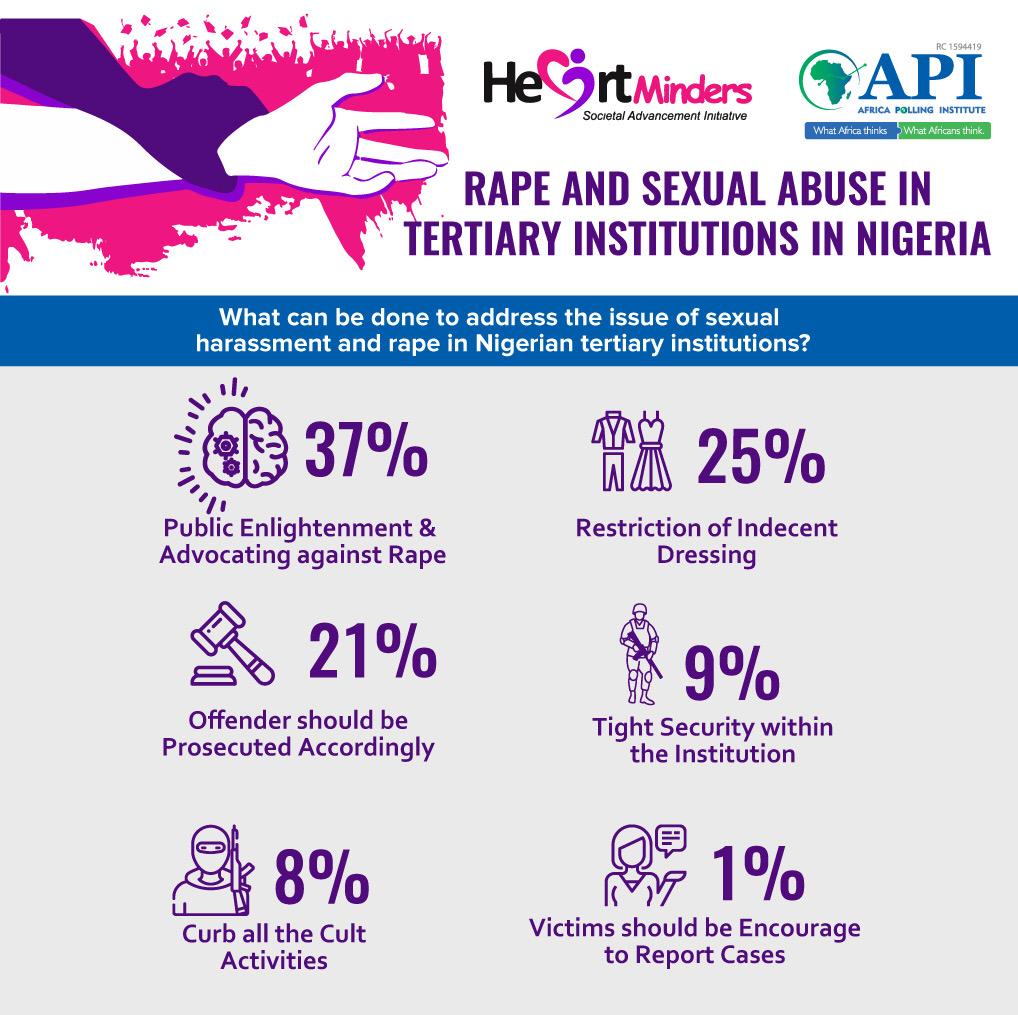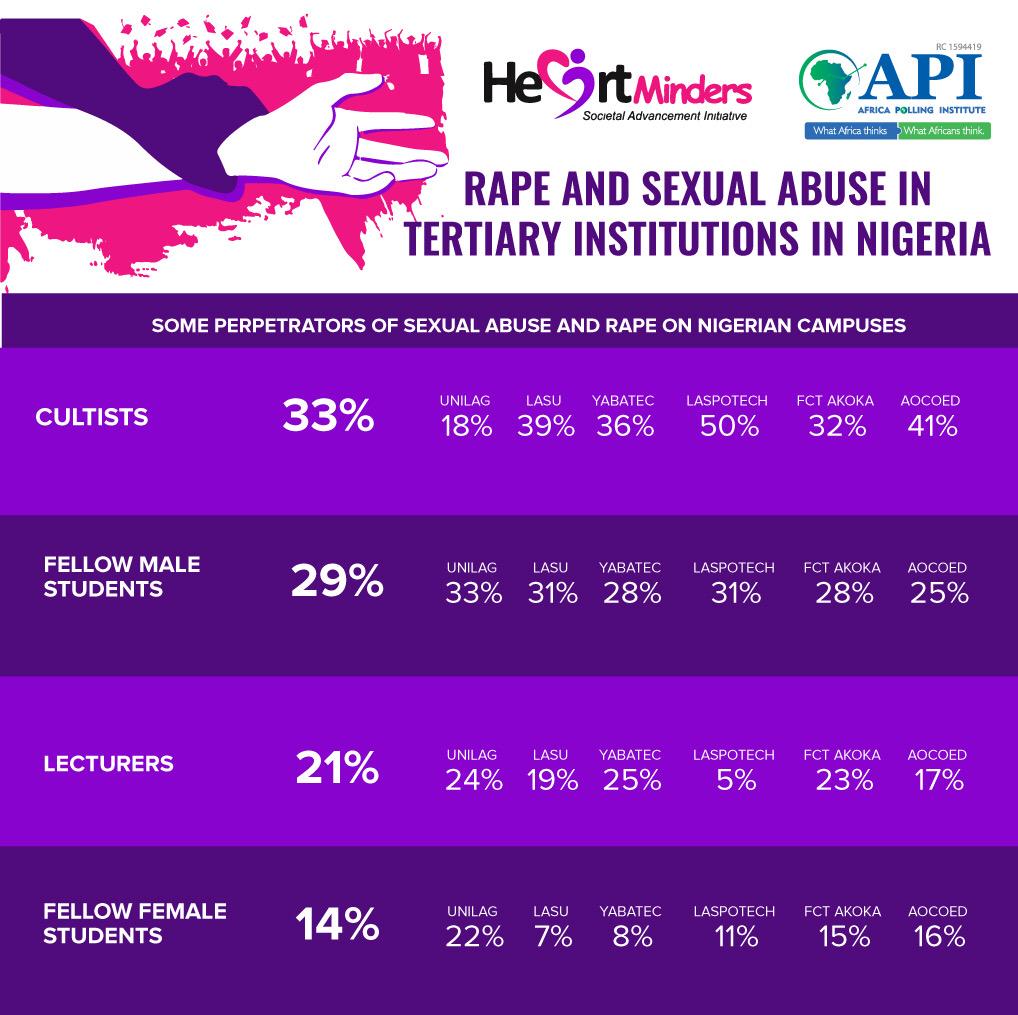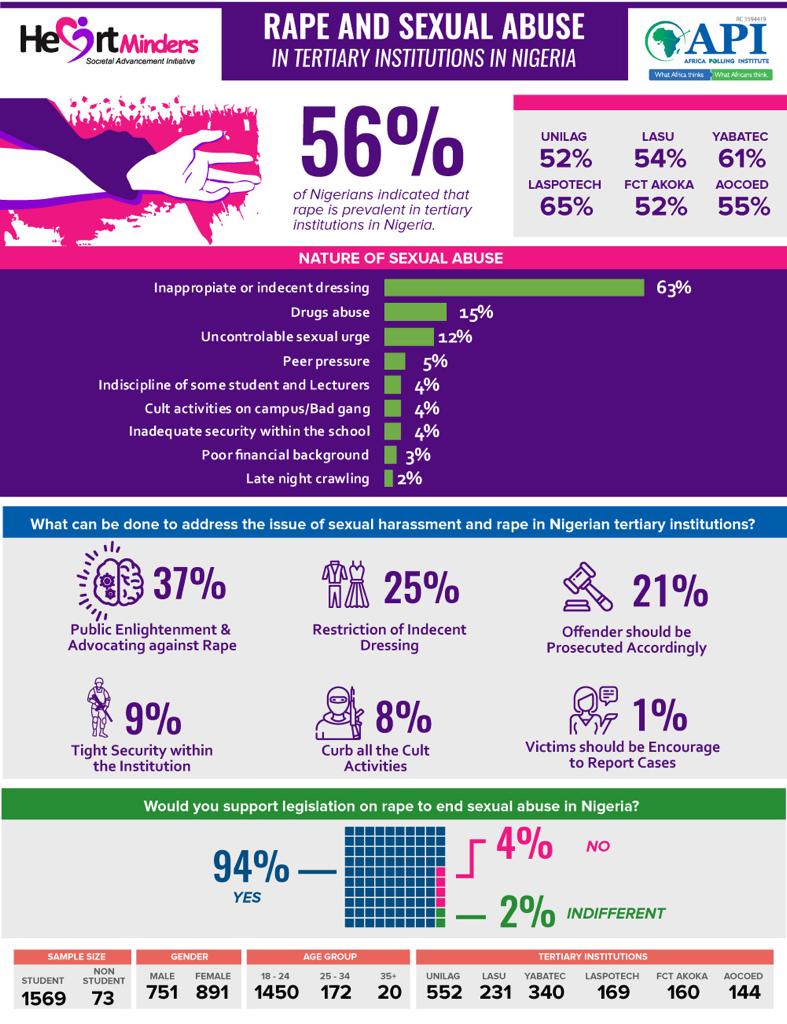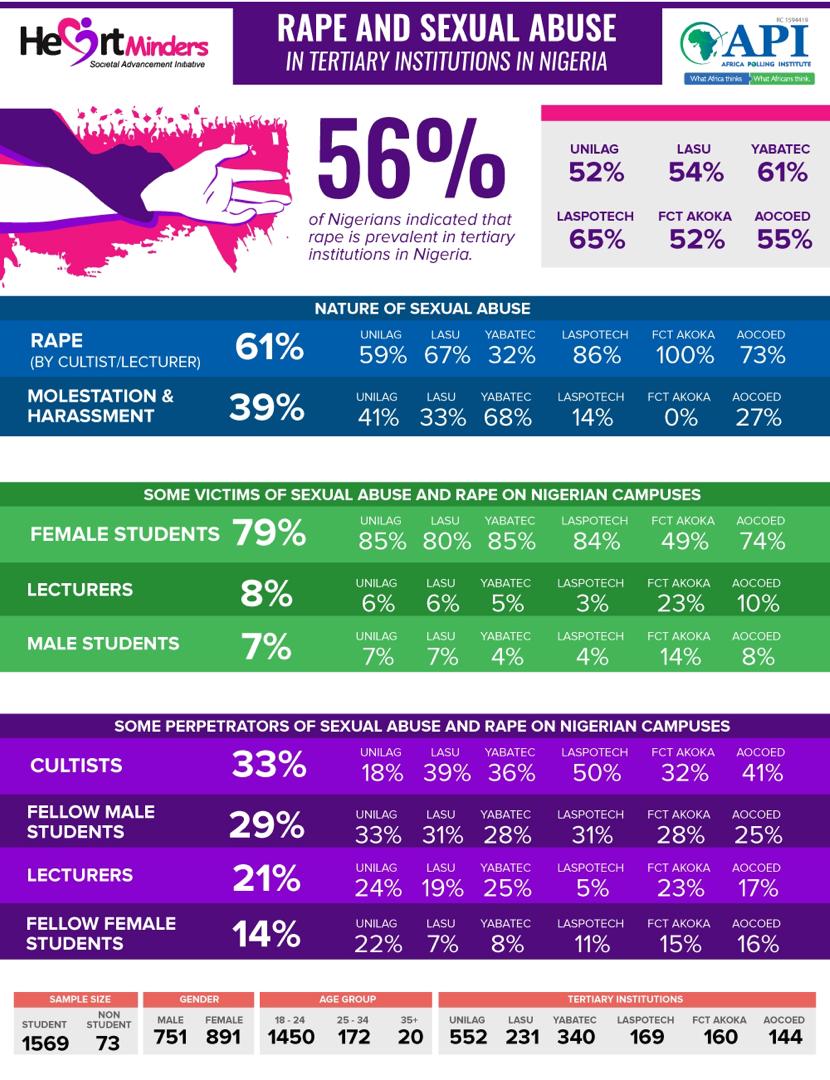The Heartminders Advancement Initiative and the Africa Polling Institute (API) has recently released the Rape and Sexual Abuse in Tertiary Institutions in Nigeria Survey Report. The report amongst other findings has revealed that cultist and lecturers are the major perpetrators of rape and sexual abuse on campuses of tertirary institutions in Nigeria. This report culminates with the recent BBC Africa Eye Documentary on Sex for Grades, which went undercover to investigate the “open secret” of sexual harassment in Universities in Nigeria and Ghana, West Africa, and to unearth some of the challenges faced by victims of sexual abuse in tertiary institutions.
To lend our voice on the subject matter, the Heartminders Advancement Initiative in collaboration with Africa Polling Institute (API) embarked on this survey to gather firsthand information from students of tertiary institutions. A total of 2,036 contacts were attempted with 1,642 interviews completed (response rate 81 percent), all respondents were aged 18 and older. All interviews were conducted between August 6th and August 20th 2019, by Face-to-Face Household Interviews, using a random sampling technique. The interviews were conducted in six tertiary institutions in Lagos state, which include: University of Lagos (UNILAG), Lagos State University (LASU), Yaba College of Technology (YABATEC), Lagos State Polytechnic (LASPOTECH), Federal College of Education (TECHNICAL) Akoka (FCTAKOKA), and Adeniran Ogunsanya College of Education Ijanikin (AOCOED).
Tertiary Institutions in Nigeria have been at the spotlight in recent times, with increasing allegations of varying degrees of sexual harassments and abuses on campuses. It has been perceived that these institutions have shown little efforts in addressing the issue. Sometimes these institutions have rebuffed these cases on the foundation that they are all lies and consequently, students who reported such cases are further victimized by these same institutions. Based on this, the survey sought to gather data from respondents to truly unravel if rape and sexual abuse in Nigerian tertiary institutions is a myth or a fact, and also, if it is a fact, to find out the prevalence of rape and sexual abuse in these tertiary institutions and who are the major perpetrators of these acts.





In unravelling the prevalence of rape and sexual abuse in institutions, the survey revealed that there is a high prevalence of rape and sexual abuse on campuses of TIs in Nigeria across the six TIs in the focus of the survey. Findings in describing the prevalence of sexual abuse in Tis revealed that majority of respondents (61%) described the prevalence of sexual abuse as either ‘Somewhat Prevalent’ (29%) or ‘Very Prevalent’ (32%); while 39% considered the prevalence of sexual abuse as ‘Not at all prevalent’ (14%) or ‘Not Prevalent’ (25%). Further disaggregation of the analysis revealed the same result across gender, age-groups and tertiary institutions. In addition, in describing the prevalence of rape in TIs in Nigeria, interestingly, a slight majority of the respondents (56%) described the prevalence of rape as either ‘Somewhat Prevalent’ (29%) or ‘Very Prevalent’ (27%); while (44%) considered the prevalence of rape as ‘Not at all prevalent’ (16%) or ‘Not Prevalent’ (28%). Further disaggregation of the data across all TIs showed that on the average, about 56% of the respondents across all TIs described the prevalence of rape as either “somewhat prevalent” (28%) or “very prevalent” (28%).
From the survey, in unravelling the category of victims of rape and sexual abuse in Tis, findings showed that the vast majority of the respondents (79%) across all TIs indicated that the major victims of rape and sexual abuse on campuses are the female students. Interestingly, 8% of respondents across all TIs indicated that lecturers (male and female) are sometimes victims of rape and sexual abuse while 7% of respondents indicated that the male students are victims of rape and sexual abuse. More findings under this revealed that majority of the respondents (61%) indicated the victims were raped by lecturers and cultists, while the remaining (39%) indicated that the victims were sexually harassed and molested.
Investigation into who the major perpetrators of rape and sexual abuse in Tis, revealed that majority of the respondents (33%) indicated that ‘cult members’ are the major perpetrators of sexual abuse and rape in TIs; this was followed closely by 29% of respondents who indicated that ‘male students’ are the major perpetrators of sexual abuse and rape in Nigeria. Interestingly, 21% of respondents highlighted that lecturers of TIs are the major perpetrators of sexual abuse and rape in TIs, and lastly, 14% of respondents indicated that female students are major perpetrators of sexual abuse and rape in TIs. These findings imply that sexual abuse or rape is not an act carried out by the male gender alone, but by both the male and female gender and it is not particular to any.
Furthermore, when cross-tabulating the data by some socio-demographics, some arousing findings were revealed. For instance, respondents who highlighted ‘cult members’ as the major perpetrators of sexual abuse and rape in TIs were seen more in LASPOTECH (50%), and AOCOED (41%). Respondents who indicated ‘lecturers’ as major perpetrators were seen more in YABATEC (25%), UNILAG (24%) and FCTAKOKA (23%). While those who indicated ‘female students’ are perpetrators of sexual abuse and rape were found mainly in UNILAG (22%).
Investigation into unravelling the reasons for the high prevalence of rape and sexual abuse in Tis highlighted that across all TIs, majority of respondents (63%) are of the opinion that ‘inappropriate and indecent dressing’ is the major reason why sexual abuse and rape is common on campuses of TIs in Nigeria. However, 36% of respondents were of the opinion that: ‘drugs abuse’ (15%), ‘uncontrollable sex urge’ (12%), ‘peer pressure’ (5%), and ‘cultism’ (4%) are among the top major reasons for the high prevalence of sexual abuse and rape in TIs in Nigeria. Other reasons given by respondents were ‘indiscipline by some students and lecturers’ (4%), and ‘inadequate security within campuses in TIs’ (4%).
In summary, the survey has brought to light the prevalence of rape and sexual abuse in Nigerian Tis; an act majorly carried out by cultists and lecturers in TIs. It has also shown that female students are the major victims of rape and sexual abuse in Tis in Nigeria. All these point to the fact that rape and sexual abuse in Tis in Nigeria is a fact and not a myth. Therefore, a large chunk of responsibility is vested upon authorities of Tis to rise up and address this issue decisively.
Authorities in TIs should provide guidelines on the conduct of staff, ensure staff of TIs conduct themselves properly, and follow these guidelines when discharging their respective duties. They should be serious in handling allegations on rape and sexual abuses on campuses by thoroughly investigating cases tabled against the conduct of their staffs and ensure victims are well protected and not victimized during this process. This will go a long way to address the issue of fear and victimization usually faced by students.
Authorities in TIs should work hand in hand with relevant security agencies to provide adequate security around the school environment and even outside the school environment in order to address the issue of cultism and curb their activities.
CSOs, Rights Groups, and relevant stakeholders should intensify efforts to stop rape and sexual abuse through public enlightenment in order to reduce stigmatization; and develop strategies to advocate against rape and sexual abuse in the society. Also, proper counselling should be given to victims and encourage them on the need to speak up so offenders can be properly prosecuted accordingly.
Finally, authorities in government should show more commitment to end rape by reviewing legislation on rape and sexual abuse; implementing and ensuring laws on rape and sexual abuse are executed fully.








